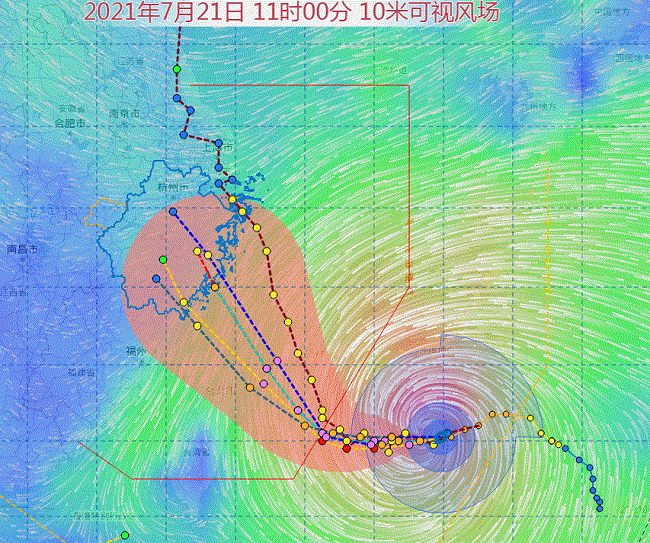Typhoon In-Fa to make landfall in Zhejiang

Typhoon In-Fa's 10-meter visible wind field at 11 am on July 21. [Photo/WeChat account: zjzsrbs]
Typhoon In-Fa, the sixth typhoon this year, is expected to make landfall at the coastal regions of Zhejiang and Fujian on July 24 or 25.
The wind level near the center of the typhoon was 14 as of 11 am on July 21.
The center of Typhoon In-Fa was located in the northwest Pacific Ocean, 560 kilometers away from Yilan county in Taiwan province at 2 pm on July 21. It is expected to move westward at a speed of 10 km/h and gradually increase in strength.
There will be showers or thunderstorms in most areas of Zhejiang from July 22 to 26.
The Zhejiang Provincial Department of Water Resources launched its Level IV emergency response to fight floods and typhoons on the morning of July 21.
It requires relevant governments to initiate emergency responses to keep an eye on the heavy rainfalls brought by Typhoon In-Fa and prepare for pre-warnings and predictions of heavy rains, water engineering dispatch and technological support for flood prevention, and rescue work in order to protect people's lives and property.
Here are some do's and don'ts before and after a typhoon.
Before a typhoon:
Keep an eye on the latest pre-warnings and predictions for the typhoon.
Halt mass gatherings, aloft work, and operation at sea.
Vessels operating at sea should return to port as soon as possible.
Consolidate or dismantle unauthorized structures.
Do not go out and people in low-lying areas or dilapidated buildings should move to a safer place.
Close doors and windows and move potted plants and other outdoor articles into the house.
Check electric circuits and gas piping and reserve some emergency food if necessary.
Keep an eye on possible torrential floods and other geological disasters.
During a typhoon:
Do not shelter from the rain under a tree, an iron tower, or an advertising board.
Do not swim or boat on rivers.
Turn off electrical equipment and cut off unnecessary power supply.
Park the car in an underground parking lot and make sure the parking lot's drainage system is unobstructed.
After a typhoon:
Clean up to prevent the spread of hazardous substances and germs.
Discharge water, harvest, and plant crops to reduce agricultural losses.
